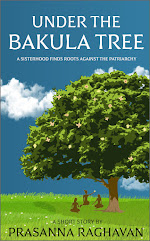How do you recognise patriarchy in everyday life?
In patriarchal social constructs, women are undervalued not because they give birth, as many think, but as per patriarchal social constructs. Genderism is a deliberately constructed power structure putting men at the centre and women at the periphery. This is a universal construct, though it takes variations based on the cultural, historical, religious and belief systems that reign each nation.
Before considering patriarchy in everyday life, let me consider how the term is explained in general studies.
The post I wrote just before this was What does feminism actually mean? I concurred that the more meritorious meaning of feminism is that given by intersectional feminism. Feminism "is just about acknowledging the interplay between gender and other forms of discrimination, like race, age, class, socioeconomic status, physical or mental ability, gender or sexual identity, religion or ethnicity." And now, let us consider what is the meaning of patriarchy?
What is the meaning of patriarchy?
Patriarchy is defined in numerous ways. The one I found to be preferred is given below.
"Patriarchy is a system of relationships, beliefs and values embedded in political, social and economic that structure gender inequality between men and women. Attributes seen as "feminine" or pertaining to women are undervalued, or attributes regarded as "masculine" are privileged. Patriarchal relations structure private and public spheres, ensuring men dominate both." To read more, go to this link.
As intersectional feminism acknowledges the interplay between gender and other forms of discrimination, it places gender as the centre of discrimination and interplaying with the other forms of discrimination. So, what is the understanding of gender?
And what are gendered constructs?
Gender in feminist scholarship is not considered as biological givens. "Gendered behaviours, expectations, practices and roles are seen as reflective of social and cultural processes and not biological 'givens'".
In patriarchal social constructs, women are undervalued not because they give birth, as many think, but as per patriarchal social constructs. Genderism is a deliberately constructed power structure putting men at the centre and women at the periphery. This is a universal construct, though it takes variations based on the cultural, historical, religious and belief systems that reign each nation.
In the present times, in many societies, governments and interested groups are reconsidering the existing social constructs and are transforming them to suit human growth and development. And are revisiting the current social constructs that give men power in private (homes) and public.
In traditional societies deeply entrenched in beliefs and religion, the rate of this change is making only slow changes in their real lives and mindsets. They call it culture and take pride in the discrimination. To read more, go to this link.
Based on the above, how do I recognise patriarchy in everyday life?
How do you recognise patriarchy in everyday life? When you try to recognise patriarchy in everyday life, the question is which society you live in.
Though no society globally is unaffected by patriarchal social constructs, its impacts on daily life differ in different societies. In the present day, its effects on societies taking liberal approaches are different from those in traditional societies.
In the traditional patriarchal social system, men are still the highest authorities and cannot be questioned by women. We term it as male domination, male prejudices against women, or male power.
Patriarchy in everyday life in traditional societies.
- Men are the sole decision-makers, and the entire family and nation follow.
- In private or in domestic circles, the father or the elder male decides things. They do not discuss it with younger men or women. If the men are not strategic decision-makers and do not make wise decisions, the entire family suffers.
- In public, the same thing happens. Men are leaders in governments and administration. Women's representation is less in the political and administrative system, and those few who get positions often cannot veto men's decisions or emulate the behaviours of male domination.
Less consideration for human nature.
- In traditional societies, cultural and religious norms play over any human realities. A familiar example is family honour. Human nature is getting sentimental and emotional. And patriarchal social constructs do not recognise this.
- And in traditional societies, women also act as part of patriarchy. We hear of young women murdered by parents for showing love interest in a man unacceptable to them because of social constructs of social hierarchies.
Male domination and violence.
- Domestic and intimate partner violence is the reason for femicide globally.
- According to a UN study in 2012, some national violence studies show that 70% of women have experienced physical and/or sexual violence in their lifetime from an intimate partner.
Male and female aggression.
- In traditional societies that are socially graded, not all men enjoy equal power of domination.
- In such cultures or nations, the men given more power as per the social/religious construct have the right to dominate other men in the lower rungs.
- In such societies, women also assume domination per the graded social construction. They join men in assisting them that the social construct of genderism is practised and implemented well. In such societies, women seemingly cannot form a joint position of feminism to address gender discrimination.
Psychological issues.
- Girls and women undergo pressures to conform to the socially constructed lifestyle. This puts a lot of pressure on them and often results in psychological issues.
Groups of men and women.
- It is not true that all men and women in traditional societies follow patriarchal gender constructs.
- Groups of men and women are there to break away from those constructs to build a better, peaceful, sensible and non-graded society.
Take away.
Very few lucky ones have escaped the razor blades of the patriarchal gender constructs. In my paternal home, I never have experienced patriarchy. Marriage threw me into the crackling embers of patriarchy. And I fought tooth and nail against it. Have you suffered from the gendered social constructs of patriarchy? Please share it here.
This is the post 9/10 in Blogchatter Half Marathon.








0 comments
Post a Comment